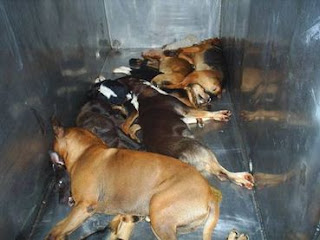Every day, 7 days a week, New York City Animal Care & Control creates a nightly "kill list". The only days a list is not created are those when the next day is a holiday, or because of major weather conditions, and the shelter will be closed.
In my watching of the kill lists, I've seen animals just days old and seniors of 12+ years. Animals killed because of a runny nose, a slight cough, a single sneeze. Animals killed because they didn't do well on their evaluation, mostly due to the stress and fear being in this shelter causes - especially those surrendered by the only family they've ever known.
NYCACC’s qualifications for the Wall of Shame:
· Phone number is not listed
· No one answers the phone – “keep trying” is the mantra
· Must be a local adopter to put a hold on an animal
· Must be a pre-approved New Hope rescue organization
· Fired a New Hope department employee because she cared too much
· Only about 20 percent of the dogs at AC&C are viewable for adoption at any given time
· Failure to take detailed information about animals from owner surrenders
· Rating system that gives ACC the power to deny an animal a chance at life
· A director who tries to cover her incompetence and the issues with smokescreens and lies
· Killing animals that have a rescue hold
· Deplorable conditions including dogs wallowing in their own waste; bed sheets soaked and soiled; cages caked with filth; cat food mixed with kitty litter
· Employees and volunteers threatened with termination if they make negative comments about the organization
· A breeding ground for disease – a cold or kennel cough is a death warrant
· Animals labeled as diseased or “bad” to justify killing them
· Perfectly healthy and adoptable animals are killed
· Failure to advertise and market animals for adoption
· Volunteers terminated for speaking out
· Suspended all new rescues that were recently approved
· Animals do not receive needed medical care or medicine
· Volunteers are asked to pay for the privilege and check their constitutional rights at the door
· Fired an extremely dedicated volunteer who gave more than 750 hours of his time to help scared dogs open up plus countless hours at home writing about and advocating for them
If you are as horrified, disgusted and angry as I am about NYCACC, use this contact form to send an email blast to the Mayor, NYC AC&C, City Council, etc.
Please keep your comments polite and respectful. Remember that you catch more flies with honey than with vinegar. Not to mention that ‘impolite’ (to put it mildly) messages are often discarded and may actually cause them to not take us seriously.
Please help spread the word about NYCACC. Change will not happen without awareness, and it will not happen without our speaking out.
Links:
Posting of each night's kill list:





